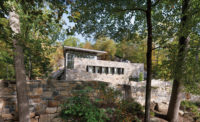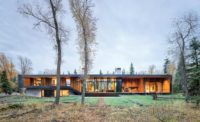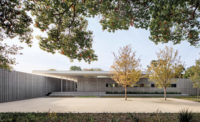At first blush, it is not clear that the low-slung glass-and-metal building is a house at all. Marching determinedly over its 216-foot-wide lot on a quiet residential street in Chicago’s Lincoln Park, the structure is an enigma—its mass and materials belie its domestic program. Around it, the coveted leafy neighborhood on the city’s North Side just west of Lake Michigan, largely rebuilt after the Great Chicago Fire of 1871, is an eclectic collage of historic row houses, interspersed with courtyard apartment buildings and high-rise condos. Surprisingly, this newcomer fits in by standing out and, while projecting a cool urban demeanor, shelters a welcoming family home within.
Additional Information:Jump to People/Products
The clients’ story is a familiar one. For years, the couple occupied a three-bedroom condominium in the area. As their family grew to include three children, they embarked on a search to find more space. They were not willing to leave the neighborhood. “We have deep roots here,” says the wife, noting that it was important for her children to continue walking to their school and for her husband to jog early every morning in Lincoln Park, for which the area is named. When a local hospital was razed to make way for a condo-townhouse complex, the clients approached the developer. And here’s where the story becomes extraordinary: for their future home, they proposed purchasing eight adjacent townhouse lots next to a historic chapel (which remained) and surrounded by residential towers.
Finding an architect was easy. The couple had a longstanding relationship with Margaret McCurry of Chicago’s Tigerman McCurry Architects, who had designed their apartment interior and vacation home. “In terms of articulating what we wanted from this house, it was like shorthand,” says the wife. “Margaret knows us very well, and we know her very well, so we were able to skip over a large part of that initial discussion clients usually have with their architects about what their tastes are.” The wife is more of a modernist; the husband, not so much; what they agreed on was a contemporary structure of glass and steel, with a warm interior. What McCurry (who runs her firm with her husband, Stanley Tigerman) gave them is a Chicago-modern house with a classical parti. “Stanley and I have been called classical modernists, modern classicists,” notes the architect.
Working with the long, shallow site and the grid of the eight lots (which sit atop two levels of underground parking for the condominiums), McCurry envisioned a Palladian plan. An 8,000-square-foot central volume serves as the heart of the house, containing a gracious double-height entry and stair, the living room, a sprawling open kitchen that spills into a dining area, and a modestly scaled bedroom zone on the top level. This structure is flanked by courtyards and wings to the east and west— connected by glazed bridges screened with zinc louvers—that hold ancillary areas: guest quarters, his and hers studies, a lap pool and fitness center, and playrooms. The project did not originate with a huge list of required components; instead, the program evolved as the design progressed. For example, raising a portion of the lower floor 4 feet accommodated mechanicals but also enabled the addition of the pool and a Japanese bath (both heated by PVs on the green roof), which the client had always wanted.
In her extensive residential work (most of which has been in suburban or rural settings), McCurry plays with regional elements. “I’ve always enjoyed transforming the vernacular into something that has a sense of history and roots but isn’t exactly something you have seen in the neighborhood,” she says. “The client wanted a modern house, and I very much wanted to do a modern house—I was raised at Skidmore, Owings & Merrill for 11 years.” With its steel, glass-and-aluminum curtain wall, expressed structure, and strong grid, the building is unmistakably Chicagoan.
While some may not envy the prospect of cozying up to an architecturally uninspired development such as the adjacent one that replaced the hospital, an indisputable benefit was that the new house was exempt from Lincoln Park’s stringent landmark restrictions. As part of the larger project, however, construction of the house could not proceed without the developers’ approval. No doubt, they would have preferred something more historicist, in the vein of the Frenchified confection— with its mansard roof and parterres—next door. Indeed, the original drawings included a tan terra-cotta rainscreen, in deference to the condo tower. But, as a sizable investor in the overall project, McCurry’s clients did have some sway, and won over the developer with the current design, which also breaks down the scale and reduces the big house’s street presence by creating the illusion of a row of individual townhouses. In addition, the team had to agree to fast-track construction, which was completed in three years.
As the clients had hoped, the interiors have a soft side. Abundant use of glass admits generous daylight and connects inhabitants to the outdoors, in particular the picturesque historic streetscape to the south. At the same time, the east and west wings shield the house’s core, diminishing the presence of the neighboring towers, and zinc louvers and translucent laminated glazing afford ample privacy. Living areas in the main structure flow, creating an informal air, while the bedrooms upstairs are tightly choreographed in an intimate cluster. “We are a family and want to hang out together most of the time,” says the wife. However, some of the ancillary spaces feel puffy and suggest programming that was created to fill space. A restrained material palette brings things down to earth. While rugged exterior steel and zinc continue inside, Douglas fir on the floor and walls, fabric ceilings in the public areas, as well as straightforward elements like drywall and white-painted millwork imbue the spaces with a domestic quality.
The trend of choosing to stay in the city to raise children has gained a lot of traction in recent years. This house certainly proposes a new way of doing it, albeit one that’s available only to a select few and doubtful to be repeated any time soon. Here McCurry has deftly drawn on precedent and worked with a complex urban setting—one that is in part distinctly Chicagoan and in part anonymous—to create a unique family home.
PeopleArchitect Tigerman McCurry Architects 312.644.5880 Personnel in architect's firm who should receive special credit Partner in Charge: Margaret McCurry, FAIA Interior designer Tigerman McCurry Architects Engineers Structural: The Structural Shop Consultants Landscape: Artemisia Lighting: Architecture + Light Acoustical: Threshold Acoustics General contractor Bulley & Andrews Photographer Steve Hall, Hedrich Blessing Photography Client: withheld Size: withheld Cost: withheld Completion date: June 2015 |
ProductsStructural system Steel Frame – Scott Steel Manufacturer of any structural components unique to this project: Stair/Custom Metal Work & Ornamental Metal – O’Brien Metal Exterior Stair – Acadia Stairs Concrete Decks – Elliot Construction Corporation Exterior cladding Metal/glass curtain wall: Kawneer Curtain Wall, Chicago Heights Glass Moisture barrier (over curtain wall blocking): Prosoco R-Guard and Fastflash – Bulley & Andrews Zinc Cladding (Columns & Sunscreens): Tuschall Engineering Front Fence: Midwest Fence Exterior Granite Hardscaping: SIMI / Masonry by Fernando Landscape: Mariani Bamboo Garden: Foliage Design System Landscape Benches (tops): Rohan Ward Designs, LLC Landscape Benches (side louvers): Tuschall Engineering Pool/Reflecting Pool: Boilini Cement Panels (interior rooftop parapet and in garage): Cement Board Fabricators – Siteline Interior Carpentry Intumescent Paint on Structural Steel: Spray Insulations Roofing Built-up roofing: American Hydrotech Monolithic Membrane 6125 - Bennett & Brousseau Roofing Green Roof: Live Roof Windows Metal frame: Chicago Doorways Glazing Glass: Chicago Heights Glass Skylights: Energy-Glazed Systems, Inc. Interior Glass/Mirrors: Glass Works Doors Entrances (part of Curtain Wall): Kawneer Flushline & 2000T Doors – Chicago Heights Glass Metal doors: Chicago Doorways Wood doors: ACW (American Custom Woodwork), Parenti & Raffaelli Sliding doors: ACW (American Custom Woodwork), Parenti & Raffaelli Overhead Doors: Raynor Door Co. Hardware Sargent / Halliday Baillie / Rockwood / FSB / Ives / Hawa Security devices: Titan Security Services Lighting/Shades/AV Integration: Sound Specialists Interior finishes Acoustical ceilings: The Huff Company / Threshold Acoustics Framing & Plaster: RG Construction Painting: All-Tech Decorating Millwork & Casework: ACW (American Custom Woodwork) Parenti & Raffaelli: Doors Apex: Wine Cellar Paints and stains: Benjamin Moore Kitchens: Valcucine (Main House), Poliform (Guest House) Appliances: Bosch, Miele, SubZero, Wolf Closets: Misuri Emme (Master), Poliform (Children’s Bedrooms) Floor and wall tile: -Stone Source (Living Room Fireplace Travertine, glass tile in Children’s Baths) -Fine Line (Pool, Dressing, Japanese Bath walls) -Dal Tile (Pantry, Children’s and Guest Baths, Wine Cellar) -Valders (Pool, Japanese Bath floors) -The Tile Gallery (Master Bath) -Ann Sacks (Master Bath) -Edelman Leather (Master Bedroom) -Installation: Bourbon Tile Resilient flooring: Nora (Garage) Rugs: Arzu, Tai Ping, Watson Smith Raised flooring: -Wood Flooring: Dinesen – Douglas Fir/Lye and Soap Finish -Installation: Heritage Flooring Lighting Interior ambient lighting: Vode, Neo-Ray Custom, Ecosense, Artemide, Kreon, Cordula Kafka, Downlights: Focal Point, Lucifer, LiteLab, BK Lighting Task lighting: Visual Lighting Technologies, Lindsley Lighting Exterior: BK Lighting, LuxR, i2 Systems Dimming System or other lighting controls: Lutron HOMEWORKS Conveyance Elevators/Escalators: Visilift - Nationwide Lifts Plumbing Warren F Thomas Plumbing Fixtures: Dornbracht / Toto Energy Photovoltaic system: dbHMS / Studio GC (MEP-BIM Coordination) Solar Thermal System: R Carrozza Plumbing Shades: Lutron Electrical: Jamerson & Bauwens Electrical Contractors Other unique products that contribute to sustainability: Large tall volumes require large amount of light to come alive. But present day environmental stresses force all of us to significantly curtail our energy consumption. This project responds to the conflicting challenge of high light needs while constraining energy use through a careful mix of low wattage halogen, hi efficacy LED sources and sophisticated controls that achieved 50% energy savings. |



















Post a comment to this article
Report Abusive Comment